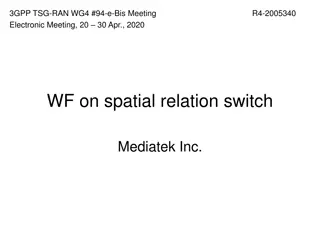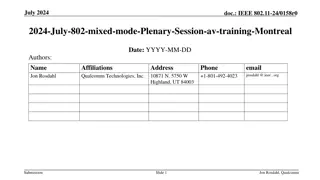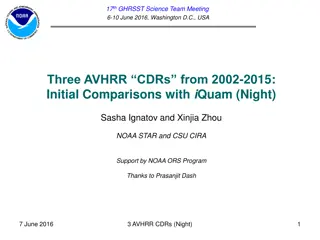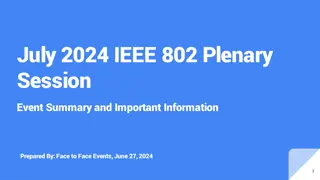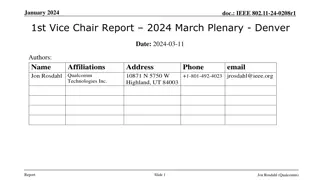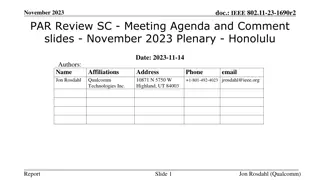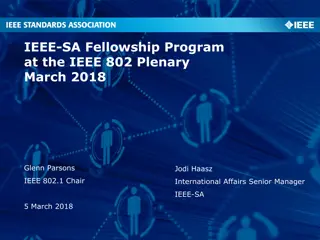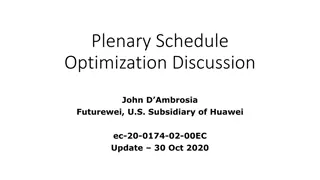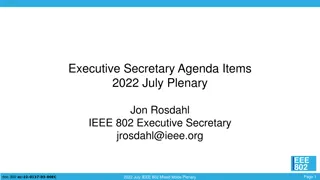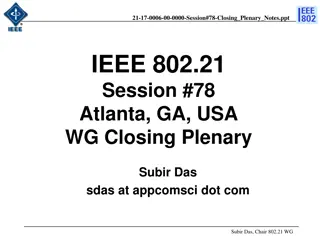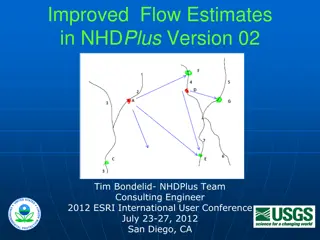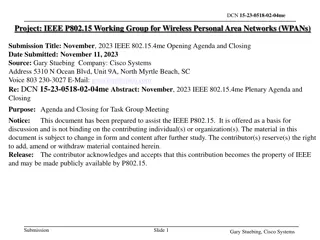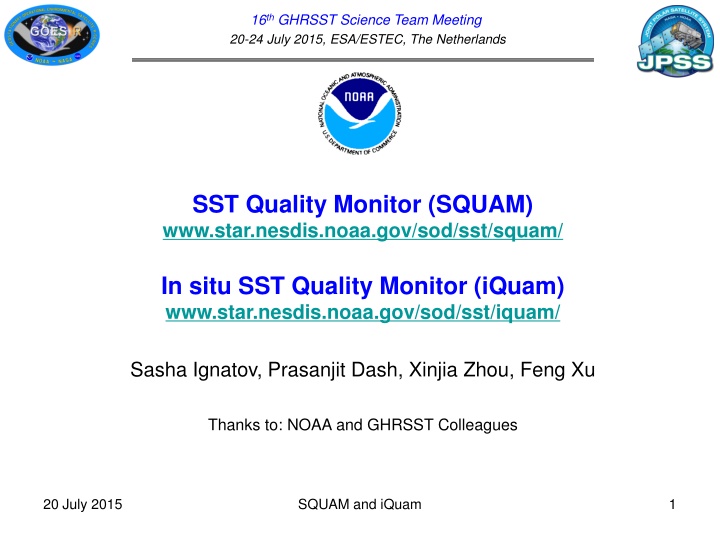
GHRSST Science Team Meeting Summary 2015 - SQUAM and iQuam Progress
Explore the advancements in SST quality monitoring discussed during the 16th GHRSST Science Team Meeting in 2015. Topics include SQUAM and iQuam modules, validation processes, community product monitoring, and plans for future enhancements. Discover the latest progress in monitoring polar L2/L3 SST products, new implementations, and improved functionalities in the SQUAM system.
Download Presentation

Please find below an Image/Link to download the presentation.
The content on the website is provided AS IS for your information and personal use only. It may not be sold, licensed, or shared on other websites without obtaining consent from the author. If you encounter any issues during the download, it is possible that the publisher has removed the file from their server.
You are allowed to download the files provided on this website for personal or commercial use, subject to the condition that they are used lawfully. All files are the property of their respective owners.
The content on the website is provided AS IS for your information and personal use only. It may not be sold, licensed, or shared on other websites without obtaining consent from the author.
E N D
Presentation Transcript
16th GHRSST Science Team Meeting 20-24 July 2015, ESA/ESTEC, The Netherlands SST Quality Monitor (SQUAM) www.star.nesdis.noaa.gov/sod/sst/squam/ In situ SST Quality Monitor (iQuam) www.star.nesdis.noaa.gov/sod/sst/iquam/ Sasha Ignatov, Prasanjit Dash, Xinjia Zhou, Feng Xu Thanks to: NOAA and GHRSST Colleagues 20 July 2015 SQUAM and iQuam 1
SST Quality Monitor (SQUAM) www.star.nesdis.noaa.gov/sod/sst/squam/ Dash, et al: SST Quality Monitor (SQUAM). JTech, 2010. 20 July 2015 SQUAM and iQuam 2
SST Monitoring in SQUAM Keywords - Google SQUAM SST or NOAA SQUAM - Validation (vs. in situ); Consistency Checks (vs. L4s) - Automated, Near-Real Time, Global, Online system SST products in SQUAM - Swath (L2) + Gridded (L3) + Analysis (L4) = 3 SQUAM modules - Initially created as a NOAA system, but now additionally monitors many community products hence GRSST resource Analyzed are deviations from reference SSTs, TS =T S TREF - Gaussian? Centered at ~0? Narrow? No outliers? - Two types of TREF 1. iQuam in situ ( Validation ). Data may be: Non-uniform in accuracy and precision (even after QC); Have sparse coverage, and geographical biases; Not always available in real-time 2. Global L4 analyses ( Consistency Checks ). More complete global coverage and uniform data accuracy and precision; Much larger match-up data sets (3-4 orders of magnitude); Available in real-time 20 July 2015 SQUAM and iQuam 3
Polar L2/L3 SST Products in SQUAM AVHRR GAC ~4km Global Area Coverage Adding in progress Keep? NOAA ACSPO RAN1 NAVO SEATEMP NOAA ACSPO U. Miami/NODC Pathfinder (L3P) A(A)TSR / SLSTR 1km MetOp AVHRR FRAC ~1km MODIS ~1km Terra and Aqua VIIRS ~0.75km U. Miami MO(Y)D28 NAVO NOAA ACSPO EUMETSAT O&SI SAF NOAA ACSPO NOAA ACSPO IDPS ARC S3 Add? Keep? Add? In addition to NOAA SSTs, SQUAM monitors several community products Feedback from data producers/users is appreciated on what to keep/drop/add 20 July 2015 SQUAM and iQuam 4
SQUAM progress since G-XV Two previously tested partners products implemented NAVO VIIRS and ARC New products under testing Polar: ACSPO 0.02 L3U (Thanks to ABoM Helen Beggs group for help with L3 code) Geo: ACSPO H8 (NOAA ACSPO) and H7 (heritage NOAA product) New/Improved functionality Gridding code optimized (CPU time reduced by ~30%) Handling of outliers improved (Maps/Histograms now available with/without ) In situ validation uniformly (re)generated for all products; Monthly statistics added CMC L4 replaced previously used RTG SST (due to improved diagnostic skill) Coming year Complete geo functionality (add ABoM and JAXA H8 SSTs) Implement ACSPO VIIRS RAN1 and L3 monitoring Redesign AVHRR GAC module; Implement ACSPO AVHRR GAC RAN1 Implement VAL against iQuam2 (including ARGO floats, IMOS ships) Consider discontinuing products with no feedback (from producers or users) 20 July 2015 SQUAM and iQuam 5
Night: ACSPO VIIRS L3U iQuam drifters (Jan Jul, 2015) Overall good agreement except in the high and low-to-mid latitudes 20 July 2015 SQUAM and iQuam 6
Night: ACSPO VIIRS L3U CMC L4 (Jan Jul, 2015) Overall good agreement except at high and in the low-to-mid latitudes 20 July 2015 SQUAM and iQuam 7
Night: ACSPO VIIRS L3U OSTIA L4 (Jan Jul, 2015) Large (+) differences in the high and recently (-) in the mid latitudes 20 July 2015 SQUAM and iQuam 8
Mean Bias wrt. in situ drifters: ACSPO H8 vs. NOAA heritage H7 SST ACSPO Himawari-8 NOAA Himawari-7 ACSPO H8 SST is within 0.2 K of drifters (vs. 0.4 K for heritage H7 SST) Some instabilities on order of 0.1 K in H8 SST may be due to sensor 20 July 2015 SQUAM and iQuam 9
Std Dev wrt. in situ drifters: ACSPO H8 vs. NOAA heritage H7 SST ACSPO Himawari-8 NOAA Himawari-7 ACSPO H8 SST compares w/drifters to within 0.4-0.6 K RMS (cf. 0.5-1.0 K for heritage H7 SST) Improved H8 performance is expected due to better AHI spatial resolution and radiometric performance 20 July 2015 SQUAM and iQuam 10
# of SST retrievals: ACSPO H8 vs. NOAA heritage H7 ACSPO Himawari-8 NOAA Himawari-7 Factor of 5 more SST retrievals in ACSPO H8 than in heritage H7 More ocean and more clear-sky pixels is expected due to superior H8 spatial resolution (2km vs. 5km at nadir) 20 July 2015 SQUAM and iQuam 11
Fraction of Clear-Sky Ocean Pixels: ACSPO H8 vs. NOAA heritage H7 ACSPO Himawari-8 NOAA Himawari-7 % of clear sky pixels is 18-27% in ACSPO H8 (compared to 12-20% in H7) Improved coverage is expected due to higher resolution of H8 (2km vs. 5km at nadir) 20 July 2015 SQUAM and iQuam 12
In situ SST QC & Monitoring in iQuam www.star.nesdis.noaa.gov/sod/sst/iquam/ Xu, Ignatov: In situ SST Quality Monitor (iQuam). JTech, 2014. 20 July 2015 SQUAM and iQuam 13
iQuam Objectives Perform the following functions in near-real time Collect in situ data for satellite Cal/Val: from various sources, covering full satellite era from 1981 pr Perform QC: Uniform, accurate, flexible, consistent with wider Meteorological and Oceanographic communities Monitor online: Statistical summaries of in situ minus reference L4 SST, stratified by platform type (drifters, ships, tropical & coastal moored, ARGO, ..; and individual platforms) Serve to users: - NOAA: L2/3/4 matchups w/iQuam are monitored in SQUAM - Felyx: Matchups and cal/val - JPL: Assimilation in L4 MUR - U. Miami: Cal/Val of satellite SST retrievals 20 July 2015 SQUAM and iQuam 14
iQuam2 (2015) additions to iQuam1 (2009) Extend iQuam period back to 1981 (using ICOADS data) Improve QC Add 2nd reference SST CMC (iQuam1 only used Reynolds SST) Add CMS black list, and individual QFs from data producers Add performance history check (iQuam version of CMS/UKMO black lists Add 4 new in situ data types (in addition to the 4 available in iQuam1 ships, drifters, tropical moorings, and coastal moorings) ARGO Floats (in 2 modes: NRT and post-processing) High-Resolution GHRSST Drifters IMOS Ships (ABoM/Helen Beggs) Coral Reef Watch buoys Improve Web interface Add daily statistics Enhance web graphics (interactive display; print/save capability) Redesign and optimize the code Change output format to NetCDF4 GDS2i 20 July 2015 SQUAM and iQuam 15
iQuam2 interface 20 July 2015 SQUAM and iQuam 16
High Resolution Drifters July 2015 High Resolution drifters are mostly found in the N. Atlantic and S. Indian/Pacific 20 July 2015 SQUAM and iQuam 17
Std Dev wrt. Reynolds L4 Performance Statistics of HR Drifters is comparable to GTS Drifters Std Dev for ARGO Floats & IMOS Ships larger (not assimilated in Reynolds) 20 July 2015 SQUAM and iQuam 18
Std Dev wrt. CMC L4 Same trends but all in situ SSTs agree better with CMC than with Reynolds CMC agrees better with ARGO Floats & IMOS ships (not assimilated in CMC) 20 July 2015 SQUAM and iQuam 19
Data for Download 20 July 2015 SQUAM and iQuam 20
Topics to discuss at G-XVI SQUAM Discuss with Yukio Kurihara, Masakazu Higaki, Helen Beggs monitoring of JAXA/JMA and ABoM H8 products in SQUAM Collect feedback on what products to keep/include. Product on which there is no feedback may be phased out. We are interested in more focused/targeted use of SQUAM resources iQuam2 NOAA plan to switch to iQuam2 in Sep 2015 any show stoppers? Feedback from current iQuam users GHRSST Guidance/Consensus on in situ data format. Currently, iQuam2 uses the GDS2i described in draft document by Tim Nightingale is it OK? Should we archive with GHRSST? Data volume is current <40GB, with 1GB/yr increment 20 July 2015 ACSPO SST Products 21
More SQUAM/iQuam Resources at G-XVI Monday, 20 July @16-18 Poster Session - Prasanjit Dash, SQUAM: Poster and Demo - Xinjia Zhou, iQuam2: Poster and Demo Thursday, 23 July @11:30-13:30 - Discussion on data standard for in situ data (including iQuam2) Thank You! 20 July 2015 SQUAM and iQuam 22




